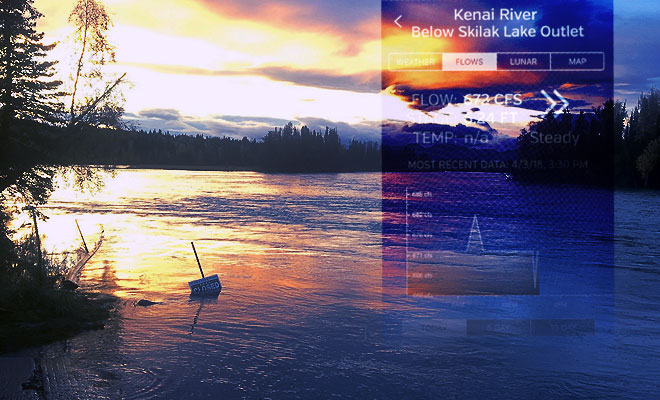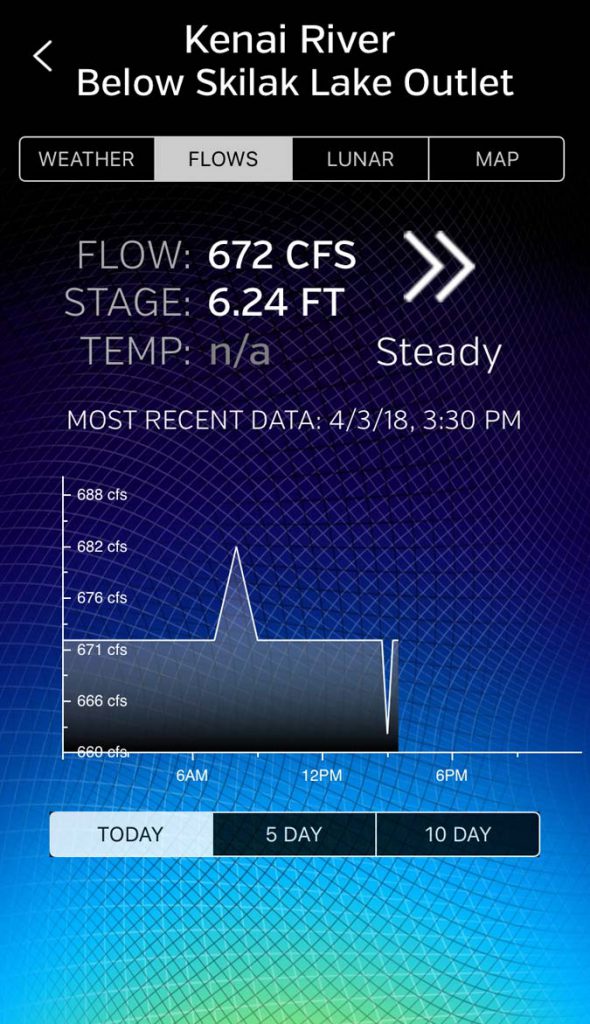 by Nigel Fox
by Nigel Fox
There is nothing more frustrating than a blown-out river when you are in the peak of the fishing season. You will go weeks with optimal water conditions and then bam, the river rises or lowers. It seems like all the fish are gone, but never fear; you can still have an amazing day of fishing.
The weather plays a key part in how the river levels change weekly and sometimes daily. Our rivers in Alaska do not get an influx of water in the beginning of the summer, unlike rivers in other parts of the country. Alaska rivers rise throughout the summer as snow pack melts gradually. Once we have hit the peak of that run-off, the rain plays a key part in raising or lower of the river. If you fish on the Kenai River it seems like you have to check the river levels (CFS – Cubic Feet per Second) as well as the weather everyday. The Kenai River, for example, specifically below Skilak Lake seems to be affected more often than the Upper Kenai River. Here on the Kenai Peninsula we get ice dams that build huge lakes of water on the glaciers that blow out from time to time and flow down the Kenai River. There are several feeder streams that feed the main stem of the Kenai River and they can be affected by lots of rain. If the summer is cooler and dry we see water levels lower. Being adaptive to the water conditions can make or break your day of fishing.
 I see the river levels rise and fall more often from late August through the end of September, which coincides with the peak of trout fishing on the Kenai River. The silver salmon are also at their peak during this time, but are not affected as much as the trout are. I would say with high-water levels the silver-salmon fishing is better. They are less spooky and we have more areas to fish them. With lower-water conditions silvers become wary, but still bite. However, with trout, they kind of get there world turned upside down with changes in river levels. The change in river levels and temperature play a key part in their feeding patterns. Generally, trout need a few day days to re-acclimate to new river conditions. Making just a few tweaks to your method of fishing can result in a better day on the water. It starts with checking water conditions the morning you are fishing. I use the FishHead app on my phone; with it, you can check flow, stage and temperature of the river. Checking the CFS is generally what I look at. I will note whether the river is up or down and then make my decision on where to go. Based on what the app tells me, I may change the area I fish or find an area that is less affected by the rising or falling of the river, lengthen/shorten my leaders, change my weight, change to a different pattern or even use a different method.
I see the river levels rise and fall more often from late August through the end of September, which coincides with the peak of trout fishing on the Kenai River. The silver salmon are also at their peak during this time, but are not affected as much as the trout are. I would say with high-water levels the silver-salmon fishing is better. They are less spooky and we have more areas to fish them. With lower-water conditions silvers become wary, but still bite. However, with trout, they kind of get there world turned upside down with changes in river levels. The change in river levels and temperature play a key part in their feeding patterns. Generally, trout need a few day days to re-acclimate to new river conditions. Making just a few tweaks to your method of fishing can result in a better day on the water. It starts with checking water conditions the morning you are fishing. I use the FishHead app on my phone; with it, you can check flow, stage and temperature of the river. Checking the CFS is generally what I look at. I will note whether the river is up or down and then make my decision on where to go. Based on what the app tells me, I may change the area I fish or find an area that is less affected by the rising or falling of the river, lengthen/shorten my leaders, change my weight, change to a different pattern or even use a different method.
Safety is most important in changing water conditions as it can be hard to navigate the river. With high water, it usually becomes off colored and you cannot spot debris moving down as you are motoring up. Lower-water conditions will make the river too shallow in areas that you have been motoring on previous days. Starting later in the morning with better light can make spotting debris and navigating shallow areas easier. There are also more people around if you need some help.
There is no doubt that changing water conditions can be a spoiler to a day on the water and can even create slight fear for some people. Being well prepared and adaptive can make the difference. Don’t let high water get you down; be well informed and make a few changes before your day starts. It will make a world of difference and possibly result in the best day of fishing you ever had.
Nigel Fox has been partners with Jeremy Anderson and Nick Ohlrich at Alaska Drift Away Fishing for more than over a decade years. He is a lifelong Alaskan and has been fishing on the Kenai River since he was a young boy. More than fifteen years have passed since his first guided trip, and each year he learns more about the intricate world of catching trophy fish on the Kenai and Kasilof rivers.
